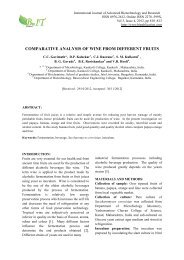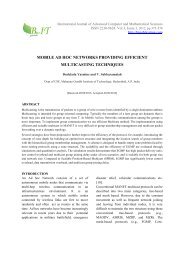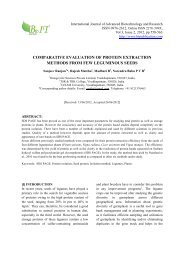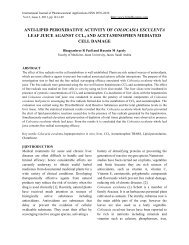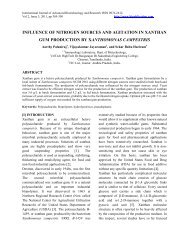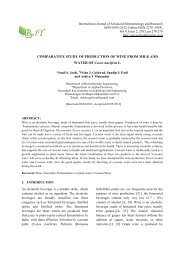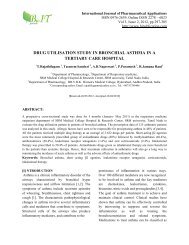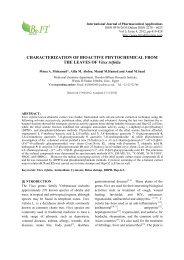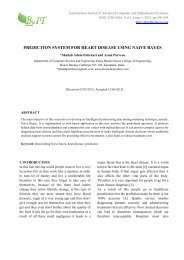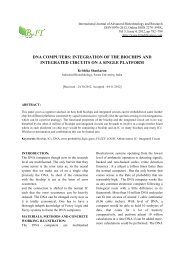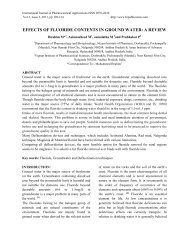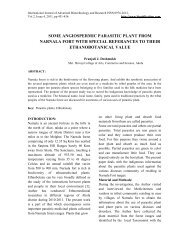isolation and characterization of chromium removing bacteria from ...
isolation and characterization of chromium removing bacteria from ...
isolation and characterization of chromium removing bacteria from ...
You also want an ePaper? Increase the reach of your titles
YUMPU automatically turns print PDFs into web optimized ePapers that Google loves.
ISOLATION AND CHARACTERIZATION OF CHROMIUM REMOVING BACTERIA3.2 Isolation <strong>of</strong> micoorganisms <strong>from</strong> theeffluent contaminated soilThe <strong>chromium</strong> resistant <strong>bacteria</strong> wereisolated <strong>from</strong> the effluent treated soil byserial dilution method, each isolated colonieswere picked up <strong>and</strong> were sub-cultured. Thebiochemical <strong>characterization</strong>s were carriedout to identify the microorganisms. Cr (VI)resistant <strong>bacteria</strong> were isolated on the basis <strong>of</strong>growth in Cr (VI) enriched medium [7]. Allthe soil samples yielded a large number <strong>of</strong>colony-forming units/mL (cfu/mL). Theserial dilution method indicated the differentcolonies in dilution <strong>of</strong> 10 -5 were found to beGram positive <strong>bacteria</strong> <strong>and</strong> gave positiveresult for catalase, starch hydrolysis <strong>and</strong>gelatine liquefaction tests <strong>and</strong> negative resultfor IMViC test indicating it to be Bacillus sp.3.3 Optimum growth characteristics <strong>of</strong><strong>chromium</strong> resistant <strong>bacteria</strong>In the present study, the optimumtemperature for <strong>chromium</strong> resistant <strong>bacteria</strong>Bacillus sp, was found to be 37°C (Figure 1).The <strong>chromium</strong> resistant <strong>bacteria</strong>, Bacillus sp,showed maximum growth at pH 7 (Figure 2).The growth curve <strong>of</strong> isolated microorganismin the presence <strong>of</strong> <strong>chromium</strong> (K 2 Cr 2 O 7 ) 10µg/mL was compared with the control (i.e nometal ions were added). There was nosignificant difference between control <strong>and</strong><strong>chromium</strong> treated culture (Figure 3). But thegrowth <strong>of</strong> the isolate was decreased in after18 hours in presence <strong>of</strong> <strong>chromium</strong>.3.4 Tannery effluent contaminated soilBoth the control <strong>and</strong> effluent contaminatedsoil samples were analysed for essentialparameters (Table 2) <strong>and</strong> it is evident that theeffluent contaminated soil has a greateramount <strong>of</strong> mineral <strong>and</strong> metal content than thecontrol soil. Chromium reducing capability <strong>of</strong><strong>bacteria</strong>l isolate was analysed by addingPotassium dichromate (K 2 Cr 2 O 7 ) at 10 µg/mLin the culture medium. The isolated Bacillussp was found to reduce 85.9% <strong>of</strong> <strong>chromium</strong><strong>from</strong> the medium within 96 h. It was alsocapable to reduce <strong>chromium</strong> (10 µg/mL) by358%, 68.9% <strong>and</strong> 74.9% <strong>from</strong> the mediumafter 24, 48 <strong>and</strong> 72 hours respectively (Figure3). The heavy metal degradation capacity <strong>of</strong>Bacillus sp was observed by well diffusionmethod (metal content ranging <strong>from</strong> 0.5, 1.0,2.0 mg/mL) respectively. The degradationcapacity <strong>of</strong> Bacillus sp was found to bemaximum at 2.0 mg/mL for <strong>chromium</strong>,copper, nickel, zinc <strong>and</strong> cadmium. The zone<strong>of</strong> degradation was found to be highest innickel. The heavy metal degradation capacity<strong>of</strong> Bacillus sp showed maximum resistanceagainst nickel, <strong>and</strong> the reduction for otherheavy metals was in the order <strong>of</strong> Ni > Cr >Cu > Zn > Cd.[IV] DISCUSSION4.1 Physiochemical properties <strong>of</strong> EffluentThe effluent released <strong>from</strong> tannery industrywas turbid, brown in colour <strong>and</strong> had an<strong>of</strong>fensive odour. The colour <strong>of</strong> the effluentmight be due to the presence <strong>of</strong>biodegradable <strong>and</strong> non-biodegradable highmolecular weight organic compounds <strong>and</strong>high amount <strong>of</strong> inorganic chemicals likesodium <strong>and</strong> <strong>chromium</strong> used during theprocessing <strong>and</strong> the odour may be due toputrefaction <strong>of</strong> the organic residues <strong>from</strong> theprocessed skin <strong>and</strong> hides. The yellowishbrown colour might be hindering thepenetration <strong>of</strong> sunlight causing depletion inthe rate <strong>of</strong> oxidation process [37;21]. Theturbidity <strong>of</strong> the effluent might be due to thedischarge <strong>of</strong> high concentrations <strong>of</strong>carbonates, bicarbonates <strong>and</strong> chlorides <strong>of</strong>calcium, magnesium <strong>and</strong> sodium [8].The normal pH range <strong>of</strong> water should bebetween 6.0 <strong>and</strong> 8.0 [4]. The effluent had ahigh pH when compared to normal waterindicating the alkaline nature <strong>of</strong> the effluentSmrithi A <strong>and</strong> Usha K 647



